Our team, working on the Empowering Local Communities through Local Language Education and Skill-Based Training (LLEST) project, has completed its first field visit to two of the five schools being supported under the project: Siddhartha Kula Basic School in Tinje, Dolpo, and Ghami Solar School in Ghami, Mustang. During this visit, the team conducted a range of activities, including orientation and community engagement, deployment and technical support, teacher and student surveys, teacher and student workshops, and user and usability testing.
(Midway through the first year of the project in 2024), after laying the foundation for project activities, securing partnerships with schools in Mustang and Dolpo, and developing the initial version of our personalized learning platform (currently, named Seepalaya), the two teams began on the field visits to these regions. The visits focused on building rapport with local communities and schools, and conducting orientations with local leaders, School Management Committees (SMCs), guardians, teachers, and students. Additionally, the teams gathered insights for skills-based courses, conducted user testing of the prototype platform, deployed offline servers with tablets, and conducted surveys with teachers to assess their educational practices and technology usage, as well as with students to evaluate their foundational reading and numeracy skills.


During the orientation sessions, our goal was to introduce the project activities to the local communities. The sessions in both schools were attended by key members from each school, including representatives from the School Management Committee(SMC), local government officials, teachers, and staff, along with a few guardians.


The sessions featured hands-on activities using the Seepalaya app, allowing participants to explore E-paath, E-Pustakalaya resources, and HRK (Hamro Ramailo Kathaharu) videos on tablets. We also demonstrated the functioning of the offline server and Wi-Fi router setup, giving participants the opportunity to experience the resources firsthand on their mobile devices and tablets. Overall, these sessions helped in establishing connections with the community, setting the stage for building partnerships and ensuring involvement and collaboration in further project activities.
During the field visits, our team successfully deployed O.L.E. Nepal's offline server, which hosted the prototype Seepalaya app, featuring E-paath, E-Pustakalaya resources, and HRK videos. We facilitated hands-on activities that allowed both students and teachers to engage directly with the Seepalaya app, exploring learning materials accessible via tablets connected to the server. Specifically, we deployed 10 tablets at Ghami Solar School and 15 tablets at Siddhartha Kula Basic School, ensuring teachers and students had direct access to the app and its resources.



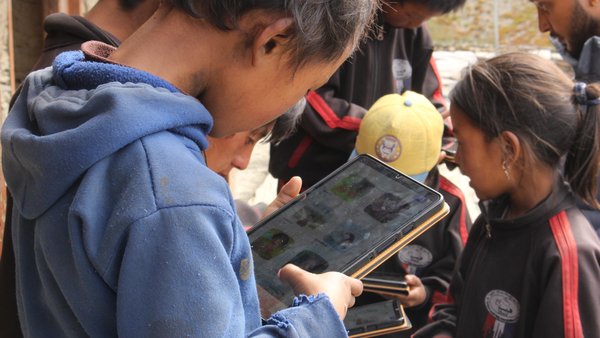
For the teachers, our team demonstrated the setup and functionality of the offline server and Wi-Fi router, enabling them to experience the resources firsthand on the provided tablets. We guided them through the process of signing up for the Seepalaya app, assisting with account creation and login procedures to access content through their profiles. Teachers actively engaged with our digital learning platforms, including E-paath, E-Pustakalaya, and HRK, discussing how these resources could enhance their daily teaching practices.
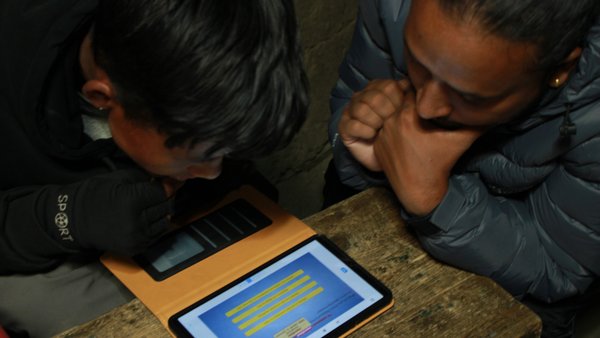

In the student sessions, we distributed tablets to each group and introduced students to the features of E-paath, E-Pustakalaya, and HRK within the Seepalaya app. This hands-on experience was helpful for familiarizing students with the app and its educational resources. We emphasized the importance of the filter and sort features, which helped them navigate and find relevant content efficiently. Additionally, we demonstrated how to view lessons and complete exercises in E-paath, further enhancing their learning experience.




Throughout the deployment and training activities, our team provided ongoing technical support. We encouraged questions and offered real-time assistance, ensuring that both teachers and students felt comfortable using the resources effectively.
During our field visits, we conducted surveys of all teachers at both schools (8 teachers at Siddhartha Kula Basic School and 10 teachers at Ghami Solar School) using a newly developed mobile survey app that facilitated easy data entry and quick data processing. Teachers filled out the survey independently or with assistance from our team members.
The survey aimed to gather insights on teachers' demographics, teaching practices, attitudes toward technology, and their familiarity with Information and Communication Technology (ICT) tools. It also assessed their current use of technology in the classroom and their experiences with professional development activities. The findings revealed that while many teachers were enthusiastic about integrating technology to enhance learning, they faced significant barriers, including a lack of training and resources. Teachers showed varied levels of familiarity with ICT tools, with some feeling confident while others sought more support and training. These insights will play an important role in designing our future activities, as they allow us to tailor our training and support initiatives to meet the specific needs of teachers within the local context. By addressing these areas, we aim to enhance the overall teaching and learning experience in the schools we work with.
Similarly, student surveys were conducted at both schools using a mobile survey app that facilitated data collection process and enabled efficient analysis. The survey was designed to address the question, “By which grade do most children acquire foundational learning skills (measured at the Grade 2 or 3 level)?” To better understand the foundational skills of students in the schools we are working with in Mustang and Dolpo, we conducted surveys targeting students from Grade 2 and above, administering a consistent questionnaire across all participants using a digitized form of the MICS6 survey.
Preliminary findings resembled the 2022 national averages, revealing that less than 30% of students aged 7 and above successfully completed all English reading tasks. While students generally demonstrated the ability to read simple sentences and short paragraphs, they struggled significantly with comprehension questions related to these readings, indicating a lack of foundational learning skills, even among older students. Conversely, the survey revealed that students performed better in numeracy tests compared to English and Nepali reading assessments.
The two-day teacher workshop at both the schools focused on exploring teachers' cultural perspectives, experiences, and challenges while leveraging technology to enhance their teaching methods. With 8 participants from Siddhartha Kula Basic School and 10 from Ghami Solar School, each 2-hour session facilitated active participation, encouraging teachers to share their philosophies, value of teaching, and the obstacles they face in their teaching processes.



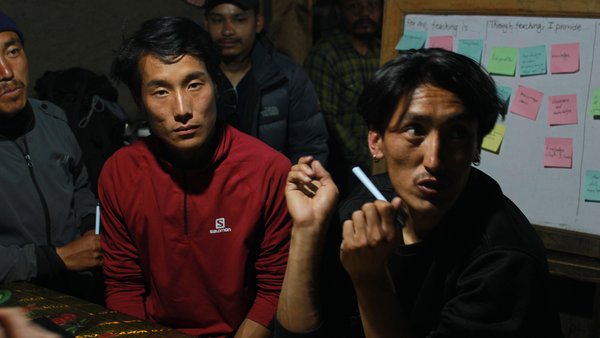
The workshops featured an Art Card Activity, allowing teachers to creatively introduce themselves, along with drawing exercises to promote self-expression. A quadrant activity incorporated into the workshop helped participants reflect on their classroom experiences where they emphasized teaching as a multifaceted role filled with joy, passion, and responsibility. While teachers expressed satisfaction in their roles, they also highlighted the need for professional development, particularly in technology, to strengthen instructional strategies.




Hands-on sessions in the workshop also involved setting up offline servers and exploring digital resources through the Seepalaya app in the tablets. At Siddhartha Kula Basic School, teachers also created multimodal lesson plans that incorporated digital learning materials from Seepalaya. During feedback sessions of the workshop, participants shared insights and suggested mentoring and assessment of their teaching practices in future. Overall, teachers found the workshop enjoyable and expressed interest in additional programs to explore a variety of teaching methodologies. The feedback gathered will inform and shape our future professional development initiatives to better meet their needs.
We had also organized three levels of workshops to engage with the student body at the schools. Many of these workshops were also attended and sometimes even co-facilitated by the local teachers themselves.


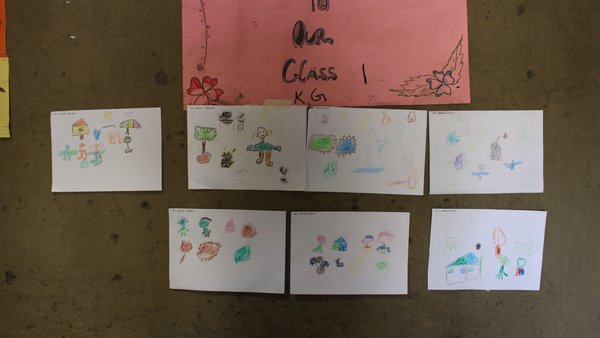

These sessions featured a drawing activity where students illustrated their imaginations, serving as an icebreaker and fostering a friendly atmosphere. By analyzing the drawings, we gained insights into students' cultural representations, emotional states, and social dynamics. This creative exercise revealed common themes that highlighted significant local elements and cultural symbols, informing our future content development. Additionally, the early-grade workshop participants also got to have interactive sessions with E-paath quizzes and HRK games, which actively engaged students and promoted their enthusiasm for learning.




Mid Grade Workshops (Grades 3-4 at Siddhartha Kula Basic School and Grades 4-5 at Ghami Solar School)
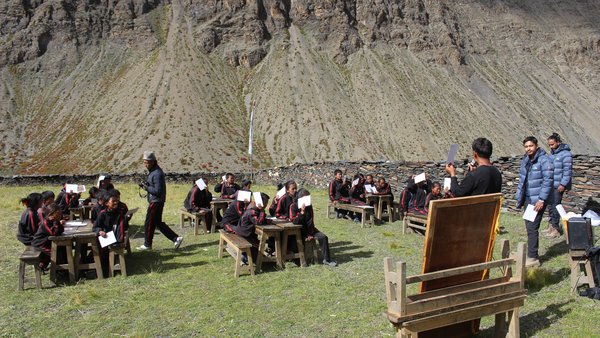

The mid-grade workshops began with the Art Card Activity, allowing students to select cards that represented their identities and introduce themselves creatively. This was followed by the "Why Activity," utilizing the "5 Whys" technique to explore their hobbies using a prompt-and-response model and promote deeper discussions within their groups. Students then engaged in a reflection exercise on chart paper, where they discussed their interests and desired travel destinations, sharing insights with the larger group. At Ghami Solar School, students also had the Map Drawing Activity that encouraged students to visualize their current and aspirational skills, fostering discussions about personal development and goals. While in Siddhartha Kula Basic School, students held a collective exhibition of their work and each group analyzed similarities and differences with their peers’ works.

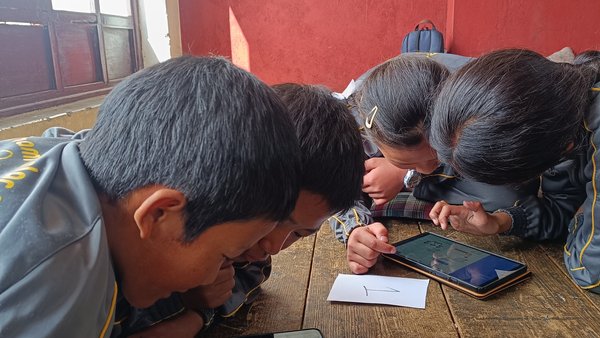
The reflections and drawings collected during this session provided valuable insights into students' interests, which will guide the development of culturally relevant learning content. Lastly, students were also introduced to the Seepalaya app in the workshop session, where they learned about key features, including navigation tools and lesson access on the tablets.


Participants at this workshop in Ghami Solar School started out with a hands-on introduction to the Seepalaya app, which helped students become familiar with the available digital learning resources and highlighted key features of the platforms for easier navigation. In both locations, at the beginning of the workshop, students participated in the Art Card Activity, selecting cards that reflected their interests for self-introduction. They then engaged in reflections on their learning journeys, discussing their feelings of happiness and engagement at various grade levels, which provided insights into their educational experiences. Following this, the Map Drawing Activity encouraged students to visualize their personal development paths.


Overall, the higher-grade workshop highlighted students' interests and engagement levels and revealed some recurring motifs. Similarly, the reflections from their "Learning Journeys" provided interesting insights into their educational experiences, such as which grade levels were the most turbulent in terms of learning history, or what students perceived as happy or sad moments in their growth. The feedback and insights gained will shape targeted skills-based courses that resonate with students' needs and interests.
Testing out how well our deployed hardware and learning platform prototype fared was also a key goal of the field visits. Prior to the field visits themselves, the team had internally brainstormed user testing best practices and usability testing prompts. The two teams incorporated user and usability testing into their program schedule based on ground conditions. While the Mustang team had some form of device engagement woven into all the workshop introductory segments that aided the team’s observation of how students and teachers used our platforms and devices, the Dolpo team set aside delegated time to run device demonstrations, running sessions in the computer lab and visiting classes as well.


Overall, we found that consolidating our learning content into one platform and providing a consistent UI (User Interface) throughout have helped users; once they understand how to navigate one sub-platform, they could navigate another section similarly. The display layout for accessing content was also intuitive for users to understand. We witnessed our users going straight to the learning content. The deployment of tablets instead of PCs or laptops also meant there was greater immediacy to user flows (not keyboard or mouse to struggle with; touchscreens are generally familiar as smartphone usage is widespread).
We were able to identify various UI/UX features to streamline as well and also identified technical bugs to address, however. This includes making the app more accessible to younger learners through visual cues, fixing landscape/portrait layout adjustment issues, and rethinking some user flows. On-the-ground user testing across such a broad range of user ages also helped us understand which platform features are less intuitive than others. Over the course of the next few months, the design team will be ironing out these issues in the second prototype of the app.
Having said that, on the field we even witnessed scenarios such as young students identifying a bug, then finding ways to circumvent it to access the content they want (eg. restarting the app and re-navigating to their earlier location on the app). Seeing this form of invested usage makes us hopeful that users will be even more excited to use our app once we have our usability fixes in the new and more polished version.
Similarly, the various conversations we had with students and teachers whether during workshops or during general engagements also provided user testing insights.
To learn more about the Hamro Ramailo Kaathaharu app visit [https://katha.olenepal.org/]